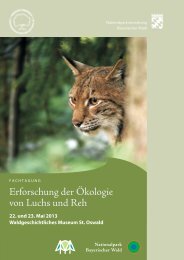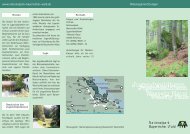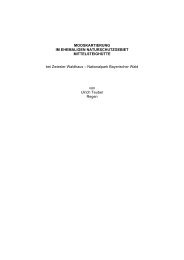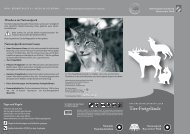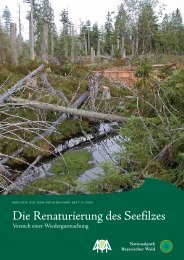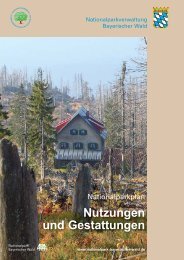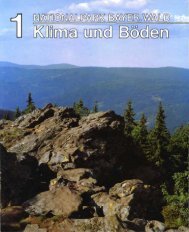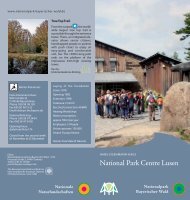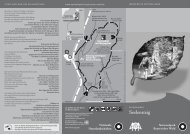The regional economic impact of Bavarian Forest National Park
The regional economic impact of Bavarian Forest National Park
The regional economic impact of Bavarian Forest National Park
Create successful ePaper yourself
Turn your PDF publications into a flip-book with our unique Google optimized e-Paper software.
Table 1: Gross tourist spending <strong>of</strong> visitors in the <strong>Bavarian</strong> <strong>Forest</strong> <strong>National</strong> <strong>Park</strong><br />
Number <strong>of</strong> visitors Daily expenditure in EUR<br />
Gross tourist spending<br />
in million EUR<br />
Visitors with a high national park affinity<br />
350,000 13.5<br />
Day-trippers 100,000 x 11.40 1.1<br />
Overnight visitors 250,000 x 49.60 12.4<br />
Other visitors 410,000 14.3<br />
Day-trippers 151,000 x 9.30 1.4<br />
Overnight visitors<br />
Source: Own research 2007<br />
259,000 x 49.60 12.9<br />
5.4 Income effects<br />
Direct income<br />
<strong>The</strong> complete gross tourist spending created from the direct<br />
expenditure <strong>of</strong> the tourists leads to the direct income. Here<br />
income or added value refers to salaries, wages and pr<strong>of</strong>it.<br />
<strong>The</strong> capture rate, i.e. the percentage <strong>of</strong> initial expenditure retained<br />
in the region, is<br />
– around 37.2 % for day-trippers and<br />
– around 37.5 % for overnight visitors.<br />
<strong>The</strong>se average values are in accordance with the specific conditions<br />
in the <strong>Bavarian</strong> <strong>Forest</strong> as they were calculated using<br />
the expenditure structure <strong>of</strong> the visitors. <strong>The</strong> capture rate,<br />
which is weighted according to the guest structure, is 37.5%<br />
for all visitors.<br />
When compared to the figures from the current study on<br />
expenditure structures in Germany, the capture rate <strong>of</strong> the<br />
overnight visitors in the national park is below the national<br />
average. Nationwide the capture rate <strong>of</strong> overnight visitors in<br />
commercial businesses, private accommodation (under 9<br />
beds) and camping is around 41.3 %.<br />
Indirect income<br />
<strong>The</strong> exact capture rates for the businesses that pr<strong>of</strong>it from<br />
the indirect income can only be derived <strong>regional</strong>ly with the<br />
help <strong>of</strong> detailed analyses. This kind <strong>of</strong> research is very expensive<br />
and time consuming and consequently was not carried<br />
out within the framework <strong>of</strong> this study. For this reason an<br />
empirically established figure from the dwif3 , which is an average<br />
<strong>of</strong> 30% was used here.<br />
Total income<br />
A total income <strong>of</strong> almost EUR 13.5 million (direct and indirect<br />
income) is derived from the gross tourist spending from<br />
day-trippers and overnight visitors in the <strong>Bavarian</strong> <strong>Forest</strong><br />
<strong>National</strong> <strong>Park</strong> (EUR 27.8 million). Around two-thirds <strong>of</strong><br />
this can be allocated to the direct income and one-third to<br />
the indirect income. <strong>The</strong> following figure (fig. 9) shows the<br />
way in which total income is created from the gross tourist<br />
spending in detail:<br />
3 Deutsches Wirtschaftswissenschaftliches Institut für Fremdenverkehr<br />
an der Universität München.<br />
Fig. 9: Calculation <strong>of</strong> the income effects in the <strong>Bavarian</strong> <strong>Forest</strong> <strong>National</strong><br />
<strong>Park</strong><br />
Source: Own research 2007<br />
13<br />
5.5 Employment effects: Income equivalents<br />
A number <strong>of</strong> parameters is needed to calculate the income<br />
equivalent, i.e. the number <strong>of</strong> full-time job equivalents deriving<br />
from the total income captured. <strong>The</strong> average aggregate<br />
income per person can be derived from the number <strong>of</strong> inhabitants<br />
in the gateway-communities and their aggregate<br />
income and lies at EUR 14,387. To calculate the income<br />
equivalent the added value generated by the national park<br />
visitors is divided by the average aggregate income per person.<br />
Differentiating between visitors with a high national<br />
park affinity and other visitors the following results occur:<br />
Visitors with a high national park affinity:<br />
EUR 6.56 million : EUR 14,387 = 456 persons<br />
Other visitors:<br />
EUR 6.95 million : EUR 14,387 = 483 persons<br />
This shows that national park visitors generate an income<br />
equivalent <strong>of</strong> 939 persons whose income relies totally on<br />
tourism in the <strong>National</strong> <strong>Park</strong>.<br />
This figure is, however, merely a book value and in reality<br />
probably more people live at least partly from tourism. This<br />
can be attributed to the fact that those employed in tourism<br />
sometimes<br />
– live only partially from tourism (e.g. renting holiday flats<br />
as a sideline) and



